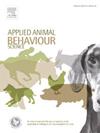Ingestive behavior of dairy buffaloes in a cow-calf contact grazing system during the post-calving
IF 2.2
2区 农林科学
Q1 AGRICULTURE, DAIRY & ANIMAL SCIENCE
引用次数: 0
Abstract
Maternal behavior immediately after calving has been widely studied in ruminants, including buffaloes. However, little is known about the cow-calf relationship in a cow-calf contact (CCC) system throughout the lactation period. The objective of this study was to investigate the evolution of ingestive behavior in dairy buffalo cows under a CCC grazing system during the first seven months post-calving and its relation with social behaviors. Ten crossbred dairy buffalo cows (Mediterranean × Murrah), including both multiparous and primiparous, and their calves, were evaluated from three days to seven months post-calving (M1, M2, …, M7). Evaluations were conducted weekly until M4 and biweekly from M5 to M7, totaling 22 observation days per cow-calf pair. Animals were kept together under continuous grazing, and their activities were observed from 9:30 am to 3:30 pm. These activities were grouped into the following categories: ingestive behaviors (idling, ruminating, grazing (min), and water intake; number of events); other behaviors (other activities, nursing, time out of water, and total time in water immersion; min); distance between cow and calf (≤ 5 m, > 5 ≤ 10 m, and > 10 m; %); and social behaviors (aggressiveness, maternal care, vocalization, nursing events and denied nursing events; number of events). In M1, buffalo cows spent 75.7 % of their time at a distance of ≤ 5 m from their calves, while in M4, this occurred only 46.5 % of the time (P = 0.001). Idling while standing was more frequent in M1 and M2 compared to the other months (P < .0001), and ruminating while standing was higher in M1 and M2 than in the subsequent months (P = 0.011). Grazing time increased from M1 (128.3 min) to M4 (173.5 min; P = 0.002). The events of aggressiveness (4.9; P = 0.098), maternal care (7.4; P < .0001), and vocalization (1.7; P < .0001) were higher in M1 when compared to M7. During the first two months of buffalo calves’ lives, cows are more vigilant and careful, increasing the time spent idling and ruminating while standing and decreasing the time spent grazing. Understanding these behaviors may help develop management practices that allow the expression of maternal care behaviors without compromising maintenance activities.
产犊后母牛-小牛接触放牧系统中乳水牛的摄食行为
在包括水牛在内的反刍动物中,对产犊后的母性行为进行了广泛的研究。然而,在整个哺乳期,人们对牛-小牛接触(CCC)系统中的牛-小牛关系知之甚少。本研究旨在探讨CCC放牧制度下水牛产犊后7个月内摄食行为的演变及其与社会行为的关系。在产犊后3天至7个月(M1、M2、…、M7)对10头地中海×默拉杂交水牛(Mediterranean × Murrah)及其犊牛进行了评价。在M4之前每周进行一次评估,从M5到M7每两周进行一次评估,每对牛共观察22天。在连续放牧条件下,将动物聚集在一起,从上午9:30 到下午3:30 观察动物的活动情况。这些活动分为以下几类:摄食行为(空转、反刍、放牧(分钟)和饮水;事件数);其他行为(其他活动、护理、离水时间、总浸水时间);分钟);母牛与小牛之间的距离(≤5 m, >;5 ≤10 m, >; 10米;%);社会行为(攻击性、母性关怀、发声、护理事件和拒绝护理事件);事件数)。在M1中,75.7 %的水牛与小牛的距离≤ 5 m,而在M4中,这一比例仅为46.5% % (P = 0.001)。M1和M2站立时空转频率高于其他月份(P <; .0001),M1和M2站立时反刍频率高于其他月份(P = 0.011)。放牧时间由M1(128.3 min)增加到M4(173.5 min); = 0.002页)。攻击性事件(4.9;P = 0.098),产妇护理(7.4;P <; .0001),发声(1.7;P <; .0001)M1比M7高。在小水牛出生的头两个月里,它们更加警惕和小心,增加了站立时空转和反刍的时间,减少了吃草的时间。了解这些行为可能有助于制定管理实践,允许在不损害维护活动的情况下表达产妇护理行为。
本文章由计算机程序翻译,如有差异,请以英文原文为准。
求助全文
约1分钟内获得全文
求助全文
来源期刊

Applied Animal Behaviour Science
农林科学-行为科学
CiteScore
4.40
自引率
21.70%
发文量
191
审稿时长
18.1 weeks
期刊介绍:
This journal publishes relevant information on the behaviour of domesticated and utilized animals.
Topics covered include:
-Behaviour of farm, zoo and laboratory animals in relation to animal management and welfare
-Behaviour of companion animals in relation to behavioural problems, for example, in relation to the training of dogs for different purposes, in relation to behavioural problems
-Studies of the behaviour of wild animals when these studies are relevant from an applied perspective, for example in relation to wildlife management, pest management or nature conservation
-Methodological studies within relevant fields
The principal subjects are farm, companion and laboratory animals, including, of course, poultry. The journal also deals with the following animal subjects:
-Those involved in any farming system, e.g. deer, rabbits and fur-bearing animals
-Those in ANY form of confinement, e.g. zoos, safari parks and other forms of display
-Feral animals, and any animal species which impinge on farming operations, e.g. as causes of loss or damage
-Species used for hunting, recreation etc. may also be considered as acceptable subjects in some instances
-Laboratory animals, if the material relates to their behavioural requirements
 求助内容:
求助内容: 应助结果提醒方式:
应助结果提醒方式:


